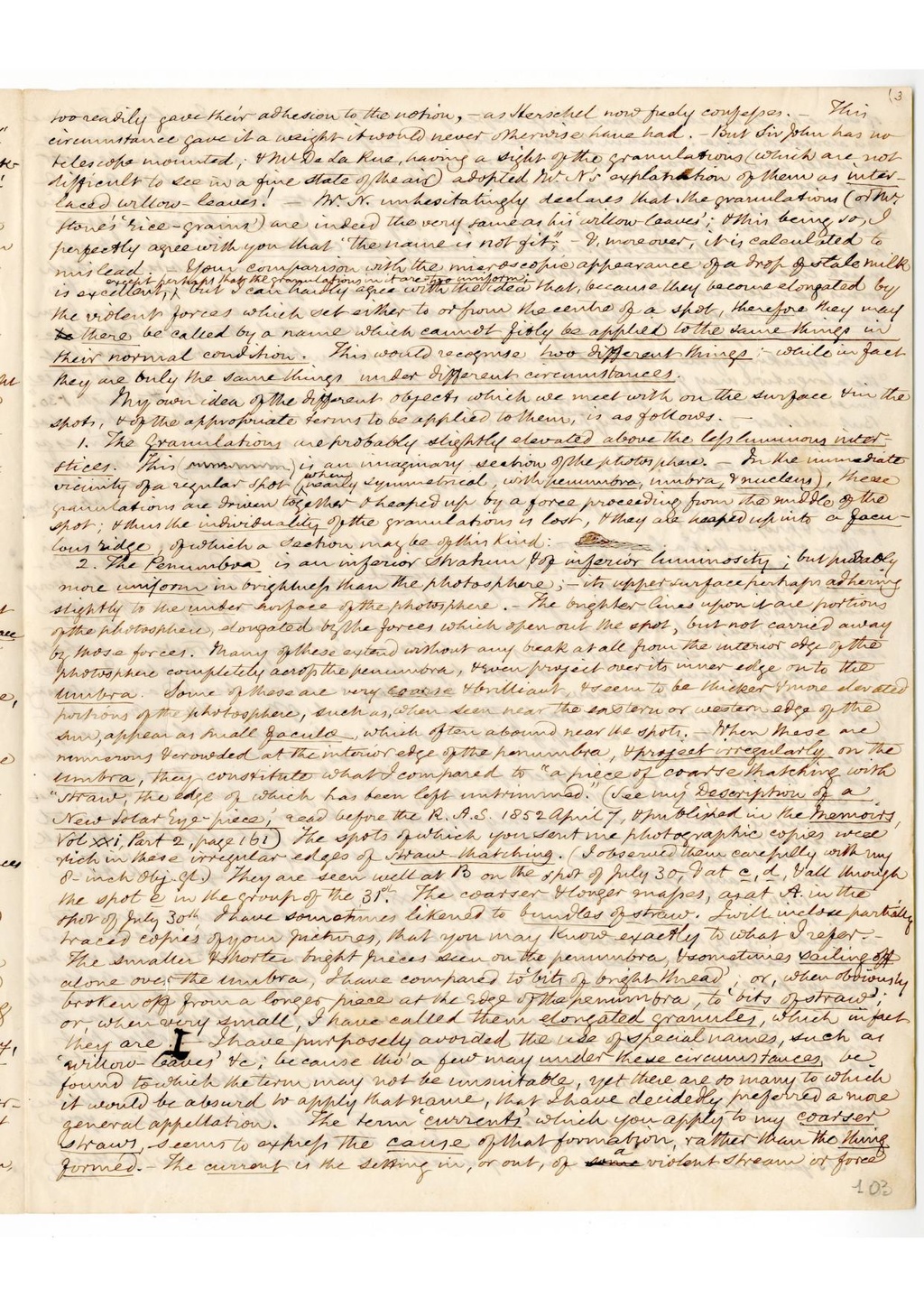too readily gave their adhesion to the notion, - as Herschel now freely confesses. - This circumstance gave it a weight it would never otherwise have had. - But Sir John has no telescope mounted; and Mr. De La Rue, having a sight of the granulations (which are not difficult to see in a fine state of the air) adopted Mr. N's explanation of them as interlaced willow-leaves! - Mr. N. unhesitatingly declares that the granulations (or Mr. Stone's 'rice-grains') are indeed the very same as his 'willow-leaves'; and this being so, I perfectly agree with you that 'the name is not fit"; - and, moreover, it is calculated to mislead. - Your comparison with the microscopic appearance of a drop of stale milk is excellent, except perhaps that the granulations in it are too uniform; but I can hardly agree with the idea that, because they become elongated by the violent forces which set either to or from the centre of a spot, therefore they may there be called by a name which cannot fitly be applied to the same things in their normal condition. This would recognise two different things; while in fact they are truly the same things under different circumstances.
My own idea of the different objects which we meet with on the surface and in the spots, and of the appropriate terms to be applied to them, is as follows. -
1. The granulations are probably slightly elevated about the less luminous interstices. This (author's drawing) is an imaginary section of the photosphere. In the immediate vicinity of a regular spot (where nearly symmetrical, with penumbra, umbra, and nucleus), these granulations are together and heaped up by a force proceeding from the middle of the spot; and thus the individuality of the granulations is lost, and they are heaped up into a faculous ridge, of which a section may be of this kind: author's drawing
2. The Penumbra is an inferior stratum, and of inferior luminosity; but probably more uniform in brightness than the photosphere; - its upper surface perhaps adhering slightly to the under surface of the photosphere. - The brighter lines upon it are portions of the photosphere, elongated by the forces which open out the spot, but not carried away by those forces. Many of these extend without any break at all from the interior edge of the photosphere completely across the penumbra, and even project over its inner edge on to the umbra. Some of these are very coarse and brilliant, and seem to be thicker and more elevated portions of the photosphere, such as, when seen near the eastern or western edge of the sun, appear as small facula, which often abound near the spots. - When these are numerous and crowded at the interior edge of the penumbra, and project irregularly on the umbra, they constitute what I compared to "a piece of coarse thatching with straw, the edge of which has been left untrimmed." (See my 'Description of a New Solar Eye-piece,' read before the R.A.S. 1852 April 7, and published in the Memoirs, Vol xxi, Part 2, page 161) The spots of which you sent me photographic copies were rich in these irregular edges of straw-thatching. (I observed them carefully with my 8-inch obj.gl.) They are seen well at B on the spot of July 30, and at c, d, and all through the spot e in the group of the 31st. The coarser and longer masses, as at A. in the spot of July 30th, I have sometimes likened to bundles of straw. I will inclose partially traced copies of your pictures, that you may know exactly to what I refer. - The smaller and shorter bright pieces seen on the penumbra, and sometimes sailing off alone over the umbra, I have compared to 'bits of bright thread'; or, when obviously broken off from a longer piece at the edge of the penumbra, to 'bits of straw'; or, when very small, I have called them elongated granules, which in fact they are.</lb>
I have purposely avoided the use of special names, such as 'willow-leaves' etc; because tho' a few may under these circumstances, be found to which the term may not be unsuitable, yet there are so many to which it would be absurd to apply that name, that I have decidedly preferred a more general appellation. The term 'currents' which you apply to my coarser straws, seems to express the cause of that formation, rather than the thing formed. - The current is the setting in, or out, of a violent stream or force
